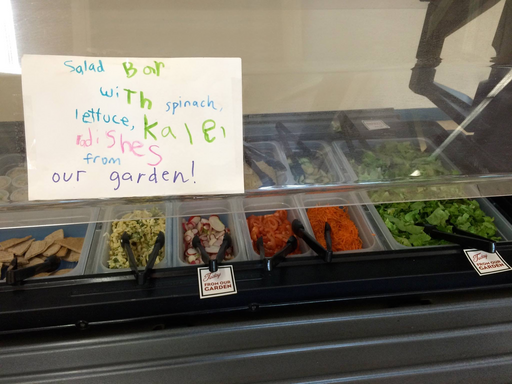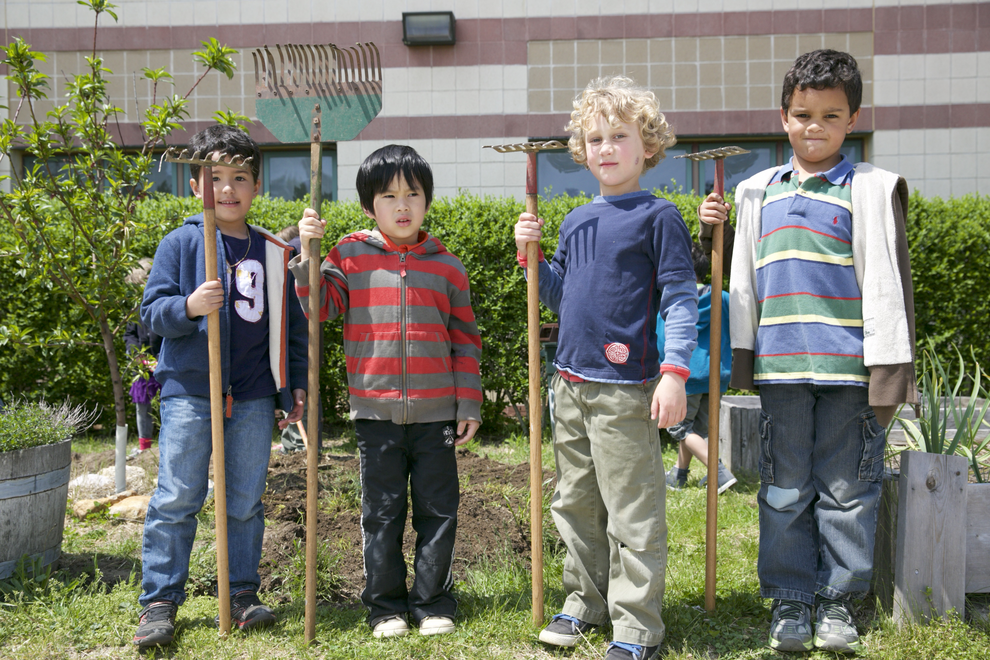The student gardeners at Oak Bluffs School shown above participate in Island Grown Schools, the farm-to-school program of Island Grown Initiative of Martha’s Vineyard. That program is just one in an array established by this nonprofit organization. Stop & Shop has supported Island Grown Initiative through the Bloomin’ 4 Good and Community Bag Programs.
Tell us about Island Grown Initiative of Martha’s Vineyard.
Island Grown Initiative (IGI) builds a regenerative and equitable food system on Martha’s Vineyard. We have a vibrant agricultural heritage on the Island, with dozens of small, local family-run farms in our community.
The organization started in 2005 when a group of farmers, grocers, mothers and other stakeholders in the local food community got together to think about what was needed to support our local farming families and strengthen our local food systems. They started by making a map of where all the farms were on the Island and what each of our farms offered. After creating the map, the group discovered that much more needed to happen to ensure that our local farmers were well-supported and that everyone living on the Island was well-fed.
Recognizing there were many problems in our food system, we developed a suite of programs to make significant, lasting changes. We started with our children by launching Island Grown Schools, our farm-to-school program. Teaching gardens were installed in all schools and 11 preschools on the Island. The team also started working with cafeteria directors on local food sourcing for schools so that kids weren’t just learning about food through their school gardens but getting access to local food in their meals. From there, a curriculum was developed because we realized every subject could be taught through the lens of food and farming. A whole generation of Island kids started with the food education program in preschool and now have graduated from high school.

Since our start, we have diversified our programming. Our programs now center on three areas: education, food equity and the 42-acre farm in the middle of the Island where we do regenerative farming. We grow about 70,000 pounds of produce annually, roughly half of which is donated to Islanders in need through our food equity programs and local partners.
What services do you provide to the community?
As an island community, we have evolved to think about our local food system as a living structure, working on every piece of the system, starting with food production. Alongside our local libraries, we help run a community seed library, where the team conducts workshops for people to learn how to save their seeds. There is a seed collection card catalog where people bring saved seeds and share them freely. Locals check out seeds, plant them and bring the saved seeds from their plants back to the collection. This has been in operation for about eight years. Over time, you start to develop locally adapted seeds that fit your environment and are delicious. The fantastic thing is that you can save seeds, for example, from one lettuce plant and then get more seeds you can use yourself. So, built into seed saving is a sense of community sharing.
As an island community, we have evolved to think about our local food system as a living structure, working on every piece of the system, starting with food production.
Seeds are one of the roots of the local food system. Over the last few generations with industrial agriculture, we’ve lost so much of the diversity of our crops. Over 90% of the biodiversity of the foods that we eat has been lost. As the number of seed companies shrinks, we don’t have as much food security as we need going into the future of changing climate. Helping people learn the age-old practice of seed saving is something that we love doing.
Then we move on to food production. Our beautiful 42-acre farm is in the middle of Martha’s Vineyard. Island Grown Initiative uses what we call regenerative agriculture practices. This utilizes very little tillage and allows grazing animals into the rotation of our crops. We keep living plants on the land all year and use cover crops that help capture the sun’s energy and feed the soil’s biology. Healthy soils help make sure that the food we grow is nutritionally-dense. Our farm strives to demonstrate how to grow food in a way that has positive environmental ripple effects, creating more positive outcomes and developing a diversity of crops with a focus on donating that food to those most in need.
Island Grown Initiative is helping everybody know how to be a food producer. We support food production through our school gardens. We teach every island kid, about 2,300 kids a year, how to grow food. Through the school gardens, we have created living laboratories in every school where they can see how food is grown and participate in that process through the seasons.
Adult education about food production is something we do as well. We organize a regenerative backyard gardeners’ network where we host classes throughout the year on how to grow fruit trees and perennial food crops and how to compost at home.
One of our core beliefs at IGI is that all people should have the right to good quality, nutritious food, and so we have a strong focus on food equity in all the work we do. Some of our programs focus on people who need to have access to free food. There are about 3,200 enrolled members in our food pantry, which is more than 10% of our year-round population.
We have our gleaning program, an age-old practice of going out to farms after the harvest to pick what’s left for people in need. We purpose-grow over 160,000 servings of fresh vegetables at our farm for donation, and glean at a number of other local farms as well. An incredible team of volunteers picks the food, and we donate it to the pantry, schools and senior centers. We also have a reduced-price mobile farmer’s market that goes around to different Island neighborhoods to provide locals with fresh seasonal food.

We also see our school-based programming as food equity work. Since we launched Island Grown Schools, the percentage of children who qualified for free or reduced-price school meals went from 12% to over 50% at many of our schools. School meals became cornerstones of child and family food security, but there were no meal options when schools were closed. So we started a Community Lunch Program that offers free lunches during summer and school vacation weeks to provide food support for anyone in need.
What sets you apart from other nonprofits in your community?
We’ve become the go-to agency for food on the Vineyard. Island Grown Initiative is the organization that’s in the middle of a vibrant local food and food equity advocacy community, helping build this local food system that looks at food production and access.
Working collaboratively helped us come up with the innovative solutions we needed to keep our community food needs met.
Our team organizes a group called the Island Food Equity Network that brings together 25 different organizations, including schools, healthcare centers, senior centers and farms, all thinking about how to keep our community well-fed. The Food Equity Network meets roughly once a quarter to identify shared needs and opportunities to collaborate. It’s easy to get siloed when doing community work, and it has been powerful to see how much we can do when we work together. The Network became particularly important when COVID hit, when food was in short supply and food needs skyrocketed. Working collaboratively helped us come up with the innovative solutions we needed to keep our community food needs met.
Tell us a story that illustrates the good work of your organization.
There is a lot of seasonal employment on the Vineyard, so many working parents are busy in the summer, and it’s hard to keep kids fed and well supported. We started the community lunch program to help this need. We would make food in our central location, volunteers would package the meals and bring them out to the lunch sites, and more volunteers would come to help serve the lunches. People started lining up.

It was the whole scope of the Island summer, and all were welcome. There was a woman who must have been in her 80s and was the primary caretaker for her husband, who had Alzheimer’s disease. Rather than sitting at home by themselves all day, she would bring him to our community lunches. They would sit at tables with kids and parents, and we would all share a meal. I remember looking at her sitting next to one of the kids who came regularly, and down the table at people that represented a wide spectrum of races, abilities, and income levels. Everyone was talking with each other about their days, their summers, their lives, sharing the same delicious food and telling stories. This is the power of a strong local food system. Food can bring us together across all our divisions, and that’s what we want for our community.
What is your most outstanding achievement or contribution to the community?
To me, one of our greatest accomplishments so far is that we have been able to develop a solid universal food education and good food program for all our Island children. The pandemic underscored that providing children with food is one of the essential roles of our schools. Many families rely on the breakfast and lunches that their children get at school. When schools were closed during the pandemic, it threw many people into challenging circumstances around having enough food to eat and feed their children. We started figuring out how to get good quality, nutritious meals to kids and families. We were able to work with all our schools and incredibly dedicated cafeteria staff to make this happen.
Making sure that all kids have an equal seat at the table to access good food feels so important.
Making sure that all kids have an equal seat at the table to access good food feels so important. Kids understand why their food choices are important and how that supports being healthy. They are also gaining skills to grow food to provide food security for themselves, their families, and their neighbors. I feel so proud that we’ve been able to do this over the last 15 years.
What do you want people to know about your organization?
Martha’s Vineyard is often thought of as a wealthy summer resort. But that is a narrow piece of this place. We have a year-round community that struggles with housing insecurity, the sky-high cost of living and seasonal unemployment. The challenge of food security is so fundamental for the people who live here. It’s incumbent on all of us to do what we can to ensure that the basic needs of our communities are being provided and that all people have access to good food with dignity. We care deeply about this, and it is at our work’s heart. We feel so proud of what we are able to do for this special place.

How are you using the funds raised from the Stop & Shop Community Bag and Bloomin’ 4 Good Programs?
Island Grown Initiative is so thankful for the funds and support provided by the Stop & Shop Community Bag and Bloomin’ 4 Good Programs. We’ve utilized funds received to support our food equity programming.
The demand for food support through our food pantry has doubled since the start of the pandemic, and food costs have skyrocketed at the same time. Being able to provide for the needs of our community has gotten expensive, and we need and appreciate all the support we can get to ensure that our community’s food needs are met.

Published February 8, 2023.
